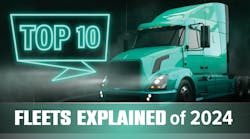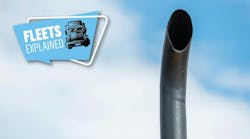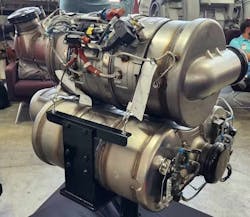When FleetOwner began the Fleets Explained series back in May, the team wasn’t sure how the industry would react. But as we began posting articles with in-depth coverage of trucking concepts like trucking segments and OEM history, we started hearing good feedback from the industry. At industry events, our team learned about interns and new hires being assigned the series as a simple way to learn more about the industry. Readers engaged with our quizzes, surveys, and emails.
It’s been encouraging on our end to know this "Trucking 101" series is informing a new generation of trucking, and we’re excited to see where the series goes in 2025. But first, let’s look back at the 10 most popular Fleets Explained articles of 2024. To submit topic ideas, clarifications, and corrections, email [email protected].
10. Fleets Explained: What is a TMS?
A transportation management system, or TMS, is a software program that manages transportation operations.
For fleets, a TMS acts as a centralized program that coordinates data collection and automates tasks across nearly every aspect of fleet operations. A TMS can communicate with a fleet’s other software programs, including telematics platforms, invoicing software, dispatcher-driver communications systems, and more.
Some companies, including shippers, will integrate a TMS within their enterprise resource planning or supply chain management programs. These systems are quickly becoming a ‘must-have’ technology for motor carriers operating multiple trucks. Read more…
9. Fleets Explained: What is cargo theft?
Thieves have preyed on cargo transporters long before trucks became the most popular and efficient way to move freight throughout the U.S. As trucking has become more sophisticated, so has cargo theft. One of the best ways for fleets to combat this crime is to better understand it.
Cargo theft is when thieves steal cargo from a shipment via plane, train, or—of course—commercial vehicles. Throughout 2024, cargo theft has only increased as a problem for the trucking industry. This article will look at the different kinds of cargo theft, what cargo is currently being stolen, when and where cargo theft occurs, prevention strategies, and what to do when cargo theft does occur. Read more…
8. Fleets Explained: Trucking industry careers
When you think of trucking careers, the most obvious is truck driver—but the industry is full of many other jobs and titles to pursue and align with various skills and experiences. The industry is full of stories about those who built up their own fleets or entry-level fleet employees who moved up the corporate ladder to leadership roles.
Younger generations, especially, might not be aware of the career opportunities in the trucking industry beyond driving. Fleets of all sizes have various positions, from on the road and in the shop to office work, including various management and executive positions.
According to the U.S. Bureau of Labor Statistics, more than 40,000 people were working as supervisors or managers in trucking and other material-moving operations in 2023. More than 56,000 were working as truck, bus, and diesel technicians, according to the BLS. The BLS said there were nearly one million workers classified as heavy-duty truck drivers in 2023. There are more than 3.5 million commercial driver’s license holders who could operate in interstate commerce, according to the Federal Motor Carrier Safety Administration.
Even with so many professional drivers and technicians out there, the trucking industry is always looking for more drivers, and various sectors experience driver and technician shortages. This means the trucking industry is a great one to currently try to break into, whether on the road, in the shop, or in the office. Read more…
7. Fleets Explained: Emissions regulations
The transportation sector is the largest source of U.S. greenhouse gas emissions, contributing 28.5% of total GHG emissions according to the U.S. EPA’s 2023 inventory of GHG emissions. Within transportation, heavy-duty vehicles contribute 23.1% of the sector’s emissions.
Heavy-duty vehicle emission regulations fall on two major authorities: the U.S. Environmental Protection Agency and the California Air Resources Board. These authorities have shaped the heavy-duty vehicle market for over 50 years and continue to do so with new rulemakings to this day. Read more…
6. Fleets Explained: DEF and NOx
Diesel exhaust fluid is the primary solution used in NOx aftertreatment. Most diesel vehicles today cannot legally operate without DEF.
But what is NOx, and why do fleets need DEF to treat it? Here is a breakdown of all the facts relevant to commercial vehicle fleets. Read more…
See also: Fleets Explained: What’s the deal with truck parking?
5. Fleets Explained: What are the trucking industry’s organizations?
Like any industry, trucking is full of trade groups and other organizations focusing on support and advocacy. Some focus on different kinds of truck drivers, while others focus on niche transportation segments.
For someone new to the industry, the number of different organizations and the common alphabet soup of abbreviations might be overwhelming. Which organization should you join and how? This Fleets Explained article outlines the major trucking organizations, what they do, and how to join them. Read more…
4. Fleets Explained: How do freight rates work?
In for-hire trucking, shippers pay carriers to move freight. This payment is generally a per-mile rate with a fuel surcharge.
Freight rates are the primary source of income in for-hire trucking and a major indicator of the industry's health.
Rates are the products of countless market conditions. Different trucking segments have slightly different rates, particularly between spot and contract freight. Read more…
3. Fleets Explained: What are trucking segments?
The trucking industry’s importance to the U.S. economy can’t be understated. Over-the-road fleets haul 72.6%—nearly 12 billion tons—of all U.S. freight. This $940.8 billion industry accounts for more than 80% of the nation's freight bill. But to an outsider—or a new industry member—how trucking is segmented can be overwhelming. Here’s a breakdown of the basic trucking segments and how the industry is categorized. Read more…
2. Fleets Explained: What do these common trucking abbreviations mean?
The trucking industry moves quickly—physically and metaphorically. In an industry in which anything can change everything at any moment—natural and unnatural disasters, legislation, technological advancements, etc.—those in trucking have to work quickly and be highly adaptable. It’s no wonder then that this industry has a high number of abbreviations that, to a newcomer, can be baffling.
To help trucking newbies tackle this learning curve, let’s go over the most common abbreviations used in the trucking industry. Generally, trucking abbreviations can be broken down into three categories: operations, equipment, and technology. Read more…
1. Fleets Explained: History of the 7 major heavy-duty truck manufacturers in the U.S.
Seven brands from four global companies account for 99.9% of all new Class 8 truck sales in the U.S. While some nascent manufacturers are entering the alternative fuel heavy-duty trucking space, the traditional trucking OEMs continue to dominate the over-the-road fleet market.
After the military was the first to extensively deploy trucks in its operations during World War I, the trucking industry grew as a new, more versatile supply chain solution in the late 1920s and 1930s. The industry experienced a boom in the 1950s and 1960s as the U.S. Interstate Highway System was developed, creating more ways to move freight along roads other than rail.
Since then, dozens of vehicle manufacturers have built heavy-duty trucks for fleets. Several of these OEM companies developed from businesses that initially produced equipment for farms, trolleys, or automobiles. Read more…
Along with these articles, FleetOwner publishes several popular annual features that garner attention throughout the trucking and transportation industries. These include our annual looks at the largest commercial transportation systems in the U.S., the FleetOwner 500: For-Hire and FleetOwner 500: Private Fleets.
Our annual profiles of women in the industry, Women in Transportation 2024, were published this summer. Each year, FleetOwner recognizes the transportation operations of private fleets with the FleetOwner Private Fleet of the Year award. This fall, we expanded and rebranded our annual New Models to the 2025 FleetOwner vehicle guide, our largest-ever look at the next generation of heavy-duty, medium-duty, light-duty, and alternative-powered trucks and vans.
We put a bow on the year with the 2024 Trucking by the Numbers feature, an info-graphical look at the facts and figures that make up the trucking and transportation industries. To view what’s ahead for FleetOwner in the new year, please check out our 2025 Media Kit.














